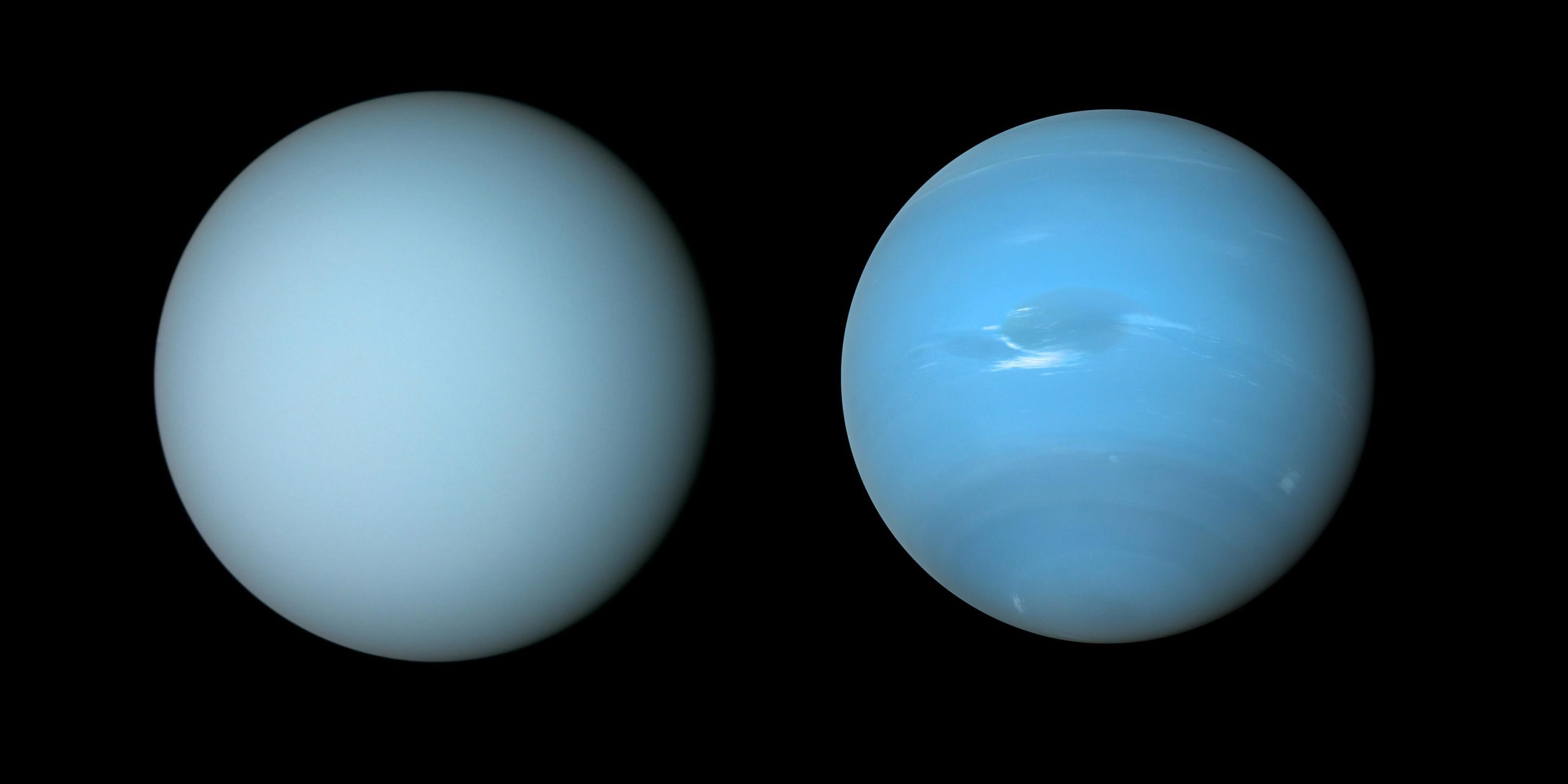
Космічний апарат NASA «Вояджер-2» зняв ці види Урана (ліворуч) і Нептуна (праворуч) під час обльотів планет у 1980-х роках. Авторство і права: NASA/JPL-Caltech/B. Johnson
Спостереження з обсерваторії Джеміні та інших телескопів виявляють надмірну туману[{” attribute=””>Uranus makes it paler than Neptune.
Astronomers may now understand why the similar planets Uranus and Neptune have distinctive hues. Researchers constructed a single atmospheric model that matches observations of both planets using observations from the Gemini North telescope, the NASA Infrared Telescope Facility, and the Hubble Space Telescope. The model reveals that excess haze on Uranus accumulates in the planet’s stagnant, sluggish atmosphere, giving it a lighter hue than Neptune.
Планети Нептун і Уран мають багато спільного – вони мають схожі маси, розміри та склад атмосфери, але їх зовнішній вигляд помітно відрізняється. На видимих довжинах хвиль Нептун помітно синіший за кольором, тоді як Уран має більш блідий відтінок блакитного. Тепер астрономи мають пояснення, чому дві планети настільки різні за кольором.
Нові дослідження показують, що шар концентрованого туману, знайдений на обох планетах, товщі на Урані, ніж подібний шар на Нептуні, і «відбілює» зовнішній вигляд Урана більше, ніж на Нептуні.[1] Якщо немає туману атмосфера З Нептуна та Урана вони обидва виглядатимуть приблизно однаковими у синьому кольорі.[2]
Цей висновок випливає з моделі[3] що міжнародна команда під керівництвом Патріка Ірвіна, професора фізики планет в Оксфордському університеті, розробила для опису аерозольних шарів в атмосферах Нептуна та Урана.[4] Попередні дослідження верхніх атмосфер цих планет зосереджувалися на появі атмосфери лише на певних довжинах хвиль. Однак ця нова модель, яка складається з кількох атмосферних шарів, відповідає спостереженням обох планет у широкому діапазоні довжин хвиль. Нова модель також включає нечіткі частинки всередині більш глибоких шарів, які раніше вважалося, що містять лише хмари льоду метану та сірководню.

Ця діаграма показує три шари аерозолів в атмосферах Урана і Нептуна, розроблені групою вчених під керівництвом Патріка Ірвіна. Висотомір на графіку відображає тиск вище 10 бар.
Найглибший шар (аерозольний шар-1) товстий і складається із суміші сірководневого льоду та частинок від взаємодії атмосфер планет із сонячним світлом.
Основним шаром, що впливає на кольори, є середній шар, який являє собою шар частинок туману (його в статті називають аерозольний шар-2), який на Урані товщі, ніж на Нептуні. Команда припускає, що на обох планетах метановий лід конденсується на частинках цього шару, затягуючи частинки глибше в атмосферу, коли випадає метановий сніг. Оскільки атмосфера Нептуна більш активна і турбулентна, ніж атмосфера Урана, команда вважає, що атмосфера Нептуна ефективніше шунтує частинки метану в шар серпанку і створює цей сніг. Це видаляє більше туману і зберігає шар туману Нептуна тоншим, ніж на Урані, а це означає, що блакитний колір Нептуна, здається, сильніший.
Над обома шарами є розширений шар туману (аерозольний шар 3), подібний до шару нижче, але більш крихкий. На Нептуні над цим шаром також утворюються великі частинки льоду метану.
Авторство: Gemini International Observatory/NOIRLab/NSF/AURA, J. da Silva/NASA/JPL-Caltech/B. Johnson
«Це перша модель, яка синхронно відповідає спостереженням відбитого сонячного світла від ультрафіолетового до близького інфрачервоного», — пояснив Ірвін, провідний автор наукової роботи, яка представляє це відкриття в Journal of Geophysical Research: Planets. «Він також перший, хто пояснив різницю у видимому кольорі між Ураном і Нептуном».
Модель команди складається з трьох шарів аерозолів на різних висотах.[5] Основним шаром, що впливає на кольори, є середній шар, який являє собою шар частинок туману (його в статті називають шаром аерозолю-2), який товстіший над Уран З Нептун. Команда припускає, що на обох планетах метановий лід конденсується на частинках цього шару, затягуючи частинки глибше в атмосферу, коли випадає метановий сніг. Оскільки атмосфера Нептуна більш активна і турбулентна, ніж атмосфера Урана, команда вважає, що атмосфера Нептуна ефективніше шунтує частинки метану в шар серпанку і створює цей сніг. Це видаляє більше туману і зберігає шар туману Нептуна тоншим, ніж на Урані, а це означає, що блакитний колір Нептуна, здається, сильніший.
Майк Вонг, астроном в[{” attribute=””>University of California, Berkeley, and a member of the team behind this result. “Explaining the difference in color between Uranus and Neptune was an unexpected bonus!”
To create this model, Irwin’s team analyzed a set of observations of the planets encompassing ultraviolet, visible, and near-infrared wavelengths (from 0.3 to 2.5 micrometers) taken with the Near-Infrared Integral Field Spectrometer (NIFS) on the Gemini North telescope near the summit of Maunakea in Hawai‘i — which is part of the international Gemini Observatory, a Program of NSF’s NOIRLab — as well as archival data from the NASA Infrared Telescope Facility, also located in Hawai‘i, and the NASA/ESA Hubble Space Telescope.
The NIFS instrument on Gemini North was particularly important to this result as it is able to provide spectra — measurements of how bright an object is at different wavelengths — for every point in its field of view. This provided the team with detailed measurements of how reflective both planets’ atmospheres are across both the full disk of the planet and across a range of near-infrared wavelengths.
“The Gemini observatories continue to deliver new insights into the nature of our planetary neighbors,” said Martin Still, Gemini Program Officer at the National Science Foundation. “In this experiment, Gemini North provided a component within a suite of ground- and space-based facilities critical to the detection and characterization of atmospheric hazes.”
The model also helps explain the dark spots that are occasionally visible on Neptune and less commonly detected on Uranus. While astronomers were already aware of the presence of dark spots in the atmospheres of both planets, they didn’t know which aerosol layer was causing these dark spots or why the aerosols at those layers were less reflective. The team’s research sheds light on these questions by showing that a darkening of the deepest layer of their model would produce dark spots similar to those seen on Neptune and perhaps Uranus.
Notes
- This whitening effect is similar to how clouds in exoplanet atmospheres dull or ‘flatten’ features in the spectra of exoplanets.
- The red colors of the sunlight scattered from the haze and air molecules are more absorbed by methane molecules in the atmosphere of the planets. This process — referred to as Rayleigh scattering — is what makes skies blue here on Earth (though in Earth’s atmosphere sunlight is mostly scattered by nitrogen molecules rather than hydrogen molecules). Rayleigh scattering occurs predominantly at shorter, bluer wavelengths.
- An aerosol is a suspension of fine droplets or particles in a gas. Common examples on Earth include mist, soot, smoke, and fog. On Neptune and Uranus, particles produced by sunlight interacting with elements in the atmosphere (photochemical reactions) are responsible for aerosol hazes in these planets’ atmospheres.
- A scientific model is a computational tool used by scientists to test predictions about a phenomena that would be impossible to do in the real world.
- The deepest layer (referred to in the paper as the Aerosol-1 layer) is thick and is composed of a mixture of hydrogen sulfide ice and particles produced by the interaction of the planets’ atmospheres with sunlight. The top layer is an extended layer of haze (the Aerosol-3 layer) similar to the middle layer but more tenuous. On Neptune, large methane ice particles also form above this layer.
More information
This research was presented in the paper “Hazy blue worlds: A holistic aerosol model for Uranus and Neptune, including Dark Spots” to appear in the Journal of Geophysical Research: Planets.
The team is composed of P.G.J. Irwin (Department of Physics, University of Oxford, UK), N.A. Teanby (School of Earth Sciences, University of Bristol, UK), L.N. Fletcher (School of Physics & Astronomy, University of Leicester, UK), D. Toledo (Instituto Nacional de Tecnica Aeroespacial, Spain), G.S. Orton (Jet Propulsion Laboratory, California Institute of Technology, USA), M.H. Wong (Center for Integrative Planetary Science, University of California, Berkeley, USA), M.T. Roman (School of Physics & Astronomy, University of Leicester, UK), S. Perez-Hoyos (University of the Basque Country, Spain), A. James (Department of Physics, University of Oxford, UK), J. Dobinson (Department of Physics, University of Oxford, UK).
NSF’s NOIRLab (National Optical-Infrared Astronomy Research Laboratory), the US center for ground-based optical-infrared astronomy, operates the international Gemini Observatory (a facility of NSF, NRC–Canada, ANID–Chile, MCTIC–Brazil, MINCyT–Argentina, and KASI–Republic of Korea), Kitt Peak National Observatory (KPNO), Cerro Tololo Inter-American Observatory (CTIO), the Community Science and Data Center (CSDC), and Vera C. Rubin Observatory (operated in cooperation with the Department of Energy’s SLAC National Accelerator Laboratory). It is managed by the Association of Universities for Research in Astronomy (AURA) under a cooperative agreement with NSF and is headquartered in Tucson, Arizona. The astronomical community is honored to have the opportunity to conduct astronomical research on Iolkam Du’ag (Kitt Peak) in Arizona, on Maunakea in Hawai‘i, and on Cerro Tololo and Cerro Pachón in Chile. We recognize and acknowledge the very significant cultural role and reverence that these sites have for the Tohono O’odham Nation, the Native Hawaiian community, and the local communities in Chile, respectively.

“Професійний вирішувач проблем. Тонко чарівний любитель бекону. Геймер. Завзятий алкогольний ботанік. Музичний трейлер”






